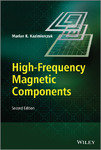Please use this identifier to cite or link to this item:
http://lib.hpu.edu.vn/handle/123456789/21351Full metadata record
| DC Field | Value | Language |
|---|---|---|
| dc.contributor.author | Kazimierczuk, Marian | en_US |
| dc.date.accessioned | 2016-06-13T03:07:01Z | |
| dc.date.available | 2016-06-13T03:07:01Z | |
| dc.date.issued | 2013 | en_US |
| dc.identifier.isbn | 9781118717790 | en_US |
| dc.identifier.other | HPU2160041 | en_US |
| dc.identifier.uri | https://lib.hpu.edu.vn/handle/123456789/21351 | - |
| dc.description.abstract | The first edition is popular among a very broad audience of readers in different areas of engineering and science. This book covers the theory and design techniques of the major types of high-frequency power inductors and transformers for a variety of applications, including switching-mode power supplies (SMPS) and resonant dc-to-ac power inverters and dc-to-dc power converters. It describes eddy-current phenomena (such as skin and proximity effects), high-frequency magnetic materials, core saturation, core losses, complex permeability, high-frequency winding resistance, winding power losses, optimization of winding conductors, integrated inductors and transformers, PCB inductors, self-capacitances, self-resonant frequency, core utilization factor area product method, and design techniques and procedures of power inductors and transformers. These components are commonly used in modern power conversion applications. The material in this book has been class-tested over many years in the author's own courses at Wright State University, which have a high enrolment of about a hundred graduate students per term. The book presents the growing area of magnetic component research in a textbook form, covering the foundations for analysing and designing magnetic devices specifically at high-frequencies. Integrated inductors are described, and the Self-capacitance of inductors and transformers is examined. This new edition adds information on the optimization of magnetic components (Chapter 5). Chapter 2 has been expanded to provide better coverage of core losses and complex permeability, and Chapter 9 has more in-depth coverage of self-capacitances and self-resonant frequency of inductors. There is a more rigorous treatment of many concepts in all chapters. Updated end-of-chapter problems aid the readers' learning process, with an online solutions manual available for use in the classroom. Provides physics-based descriptions and models of discrete inductors and transformers as well as integrated magnetic devices. New coverage on the optimization of magnetic devices, updated information on core losses and complex permeability, and more in-depth coverage of self-capacitances and self-resonant frequency of inductors Many new design examples and end-of-chapter problems for the reader to test their learning. Presents the most up-to-date and important references in the field. Updated solutions manual, now available through a companion website. An up to date resource for Post-graduates and professors working in electrical and computer engineering. Research students in power electronics. Practising design engineers of power electronics circuits and RF (radio-frequency) power amplifiers, senior undergraduates in electrical and computer engineering, and R and D staff. | en_US |
| dc.format.extent | 757 p. | en_US |
| dc.format.mimetype | application/pdf | - |
| dc.language.iso | en | en_US |
| dc.publisher | John Wiley and Sons, Ltd | en_US |
| dc.subject | High frequency | en_US |
| dc.subject | Magnetic components | en_US |
| dc.subject | Power inductors | en_US |
| dc.title | High-Frequency Magnetic Components, Second Edition | en_US |
| dc.type | Book | en_US |
| dc.size | 12.0 MB | en_US |
| dc.department | English resources | en_US |
| Appears in Collections: | Technology | |
Files in This Item:
| File | Description | Size | Format | |
|---|---|---|---|---|
| 41_High_Frequency_Magnetic_Components.pdf Restricted Access | 12.37 MB | Adobe PDF |  View/Open Request a copy |
Items in DSpace are protected by copyright, with all rights reserved, unless otherwise indicated.
